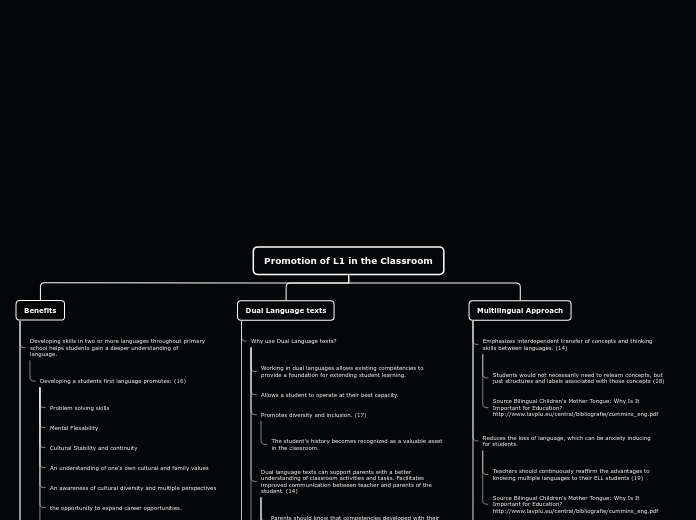Promotion of L1 in the Classroom
Benefits
Developing skills in two or more languages throughout primary school helps students gain a deeper understanding of language.
Developing a students first language promotes: (16)
Problem solving skills
Mental Flexability
Cultural Stability and continuity
An understanding of one's own cultural and family values
An awareness of cultural diversity and multiple perspectives
the opportunity to expand career opportunities.
Source: Many Roots Many Voices. Supporting English Language Learners in every Classroom, pp. 14-16
http://www.edu.gov.on.ca/eng/document/manyroots/manyroots.pdf
Draws from the students prior knowledge including existing academic, linguistic and cultural knowledge. (17)
Skills and knowledge transfer from an L1 into the L2.
50/50 bilingual language programs demonstrate that learning isn't negatively effected when two languages are fostered. (18)
Source Bilingual Children's Mother Tongue: Why Is It Important for Education?
http://www.lavplu.eu/central/bibliografie/cummins_eng.pdf
Source: Many Roots Many Voices. Supporting English Language Learners in every Classroom, pp. 14-16
http://www.edu.gov.on.ca/eng/document/manyroots/manyroots.pdf
Dual Language texts
Why use Dual Language texts?
Working in dual languages allows existing competencies to provide a foundation for extending student learning.
Allows a student to operate at their best capacity.
Promotes diversity and inclusion. (17)
The student's history becomes recognized as a valuable asset in the classroom.
Dual language texts can support parents with a better understanding of classroom activities and tasks. Facilitates improved communication between teacher and parents of the student. (14)
Parents should know that competencies developed with their children in their first language are carried into the classroom.
Allows the transfer of knowledge and skills from home-life into academic life.
Parents can be involved in the structure and design of projects. Examples include include surveys and storytelling.
Teachers should maintain communication with parents to remind them of the ELL services that are available to them and the importance of reinforcing of L1 at home.
Reinforces learning at home, alongside the classroom.
Documents, assignment sheets and important info should be provided in dual language forms so that parents are closely involved with their children's learning.
Source: Many Roots Many Voices. Supporting English Language Learners in every Classroom, pp. 14-16
http://www.edu.gov.on.ca/eng/document/manyroots/manyroots.pdf
Examples of dual language strategies: (15)
Encouraging students to write in their first language when they're new to English. Initial journals are an example. (15)
Allowing ELL students to develop ideas in their own language. (IE, mind maps) (15)
Giving ELL students chances too work with other students who speak the same first language. (IE, think, pair share) (15)
Designing activities that take advantage of then presence of multiple languages in the class. (IE, making comparisons between the different languages in relations to different things, like numbers) (15)
Creating Dual-language assignments, like the creation of books in both languages. (15)
Source: Many Roots Many Voices. Supporting English Language Learners in every Classroom, pp. 14-16
http://www.edu.gov.on.ca/eng/document/manyroots/manyroots.pdf
Multilingual Approach
Emphasizes interdependent transfer of concepts and thinking skills between languages. (14)
Students would not necessarily need to relearn concepts, but just structures and labels associated with those concepts (18)
Source Bilingual Children's Mother Tongue: Why Is It Important for Education?
http://www.lavplu.eu/central/bibliografie/cummins_eng.pdf
Reduces the loss of language, which can be anxiety inducing for students.
Teachers should continuously reaffirm the advantages to knowing multiple languages to their ELL students (19)
Source Bilingual Children's Mother Tongue: Why Is It Important for Education?
http://www.lavplu.eu/central/bibliografie/cummins_eng.pdf
Allows a holistic approach to language acquisition; reinforcement of the L1 at home is the foundation of their learning. (20)
Facilitates a synthesis of the knowledge gained in both languages.
Continued use of L1 builds from prior language knowledge, instead of rejecting it.
Source Bilingual Children's Mother Tongue: Why Is It Important for Education?
http://www.lavplu.eu/central/bibliografie/cummins_eng.pdf
Example multilingual strategies:
Dual language assignments like a bilingual advertisement brochure (14)
Allowing same language partners to discuss a topic and brainstorm in their L1 before switching to English. (14)
Creation of multilingual signs and displays (14)
Writing first drafts of projects in their L1; IE, outlines, notes, etc. (14)
Providing bilingual support like "room partners" or "cross grade tutors" who can help the student with key learning concepts (14)
Source: Many Roots Many Voices. Supporting English Language Learners in every Classroom, pp. 14-16
http://www.edu.gov.on.ca/eng/document/manyroots/manyroots.pdf
